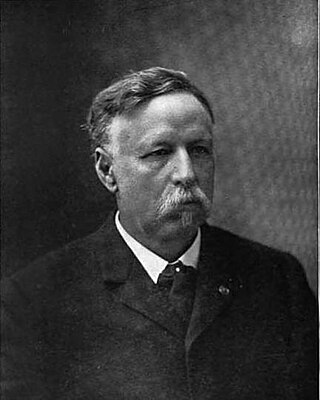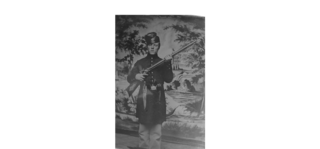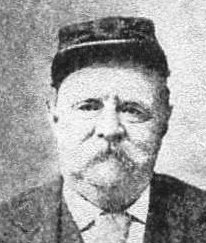The 54th Pennsylvania Volunteer Infantry was an infantry regiment which served in the Union Army during the American Civil War.

John Peter Shindel Gobin was an American politician from Pennsylvania who served as an officer in the Union Army during the Civil War, as a member of the Pennsylvania State Senate for the 17th district from 1885 to 1898 and as the seventh lieutenant governor of Pennsylvania.

The 2nd United States Sharpshooters was a sharpshooter regiment that served in the Union Army during the American Civil War. From 1861 to January 1863 they were members of the "First Iron Brigade" also known as the "Iron Brigade of the East".

Jacob Gellert Frick Sr. was a United States infantry officer who fought with several Union Army regiments during the American Civil War, including as lieutenant colonel of the 96th Pennsylvania Infantry and as colonel of the 129th Pennsylvania Infantry. He received his nation's highest award for valor, the U.S. Medal of Honor, for his gallantry during the battles of Fredericksburg and Chancellorsville, Virginia. Grabbing the American flag from his regiment's color-bearer at Fredericksburg on December 13, 1862, he inspired his men to move forward "through a terrible fire of cannon and musketry"; at Chancellorsville, he personally engaged in hand-to-hand combat on May 3, 1863, to retrieve his regiment's flag which had been captured by the enemy. He was 67 years old when his Medal of Honor was conferred on June 7, 1892.

The 114th Regiment, Pennsylvania Volunteer Infantry was an infantry regiment that served in the Union Army during the American Civil War. They were notable for their colorful Americanized version of the Zouave uniform worn in emulation of certain French light-infantry units that became world-famous during France's colonization of North Africa, the Crimean War, and the Second War of Italian Independence fought in the years prior to the American Civil War.

J. Howard Wert was an author, educator, and Civil War veteran and collector.
James Wheeler Fuller Jr. was a former officer of the 47th Pennsylvania Infantry Regiment during the American Civil War who became an American industrialist known for manufacturing railroad axles and wheels. In 1910, he was described by his local newspaper, The Allentown Democrat, as "one of Catasauqua's most useful and enterprising citizens."

The 91st Pennsylvania Volunteer Infantry was a Union infantry regiment which fought in multiple key engagements of the American Civil War, including the Battle of Fredericksburg, Battle of Chancellorsville and Battle of Gettysburg. It was established through the combined efforts of Edgar M. Gregory, who had received approval from the U.S. War Department to begin recruiting soldiers for an entirely new regiment during the fall of 1861, and Edward E. Wallace, who had initiated his own recruitment efforts that October. Their recruits were volunteers, the majority of whom initially enlisted for three-year terms of service from their hometown of Philadelphia; they were divided into 10 lettered companies upon muster in during early December 1861: A, B, C, D, E, F, G, H, I, and K.
The 75th Regiment Pennsylvania Volunteer Infantry was a unit of the Union Army during the American Civil War. It was composed almost entirely of German-speaking residents of Philadelphia and newly arrived German immigrants. Total enrollment, over the course of the war, was 1,293 officers and men. The 75th Pennsylvania participated in several major battles including Second Bull Run, Chancellorsville, and Gettysburg. The regiment was transferred to the Western Theater in September, 1863. There, it participated in operations in Tennessee, before it was mustered out of service on September 1, 1865, following the close of the war.

The 97th Pennsylvania Infantry was a Union infantry regiment which fought in multiple key engagements of the American Civil War, including the Siege of Fort Pulaski, Bermuda Hundred Campaign, Battle of Cold Harbor, Siege of Petersburg, and the Carolinas Campaign.
The 2nd Pennsylvania Cavalry was a cavalry regiment that served in the Union Army during the American Civil War.

The 157th Pennsylvania Volunteer Infantry was a Union infantry regiment which fought in multiple key engagements during the final years of the American Civil War, including the Battle of Cold Harbor, Siege of Petersburg, and Appomattox Campaign. One of two military units raised at roughly the same time in the Philadelphia area during the fall of 1862, the 157th Pennsylvania was stationed initially at Fort Delaware, beginning in December 1862, and remained there on garrison duty until it was reassigned to the defense of Washington, D.C. during the early winter of 1863. It was then assigned to the Army of the Potomac during the spring of 1864, and sent to the front lines of the war's Eastern Theater, where it remained for the duration of the war. During a reorganization of Union Army units in the spring of 1865, its men were merged with those of the 191st Pennsylvania Infantry.

Alexander H. Mitchell was a United States military officer who fought with the Union Army during the American Civil War as captain of Company A of the 105th Pennsylvania Infantry. Wounded multiple times in combat during the war, he was awarded the Kearny Cross for his distinguished service in the Battle of Chancellorsville, Virginia in May 1863, and was then also awarded his nation’s highest award for valor, the U.S. Medal of Honor for his capture of a Confederate flag in hand-to-hand combat with the color-bearer of the 18th North Carolina Infantry during the Battle of Spotsylvania Court House on May 12, 1864.

James George Mitchell was a Pennsylvania state senator and United States soldier who fought with the Union Army during the American Civil War as a drummer boy and private with Company A of the 105th Pennsylvania Infantry. He served under his older brother, Alexander H. Mitchell (1840–1913), who was later awarded the U.S. Medal of Honor for valor.

William H. Paul was an American soldier who fought with the Union Army during the American Civil War as a member of Company E of the 90th Pennsylvania Infantry and, later, the 11th Pennsylvania Infantry's E Company. He was awarded his nation's highest honor for valor in combat, the U.S. Medal of Honor, for saving and protecting the regimental flag of the 90th Pennsylvania Volunteers during the intense fighting of the Battle of Antietam in Maryland on September 17, 1862. That award was conferred on November 3, 1896.

William Sands was a United States soldier who fought with the Union Army during the American Civil War as a principal musician with the 88th Pennsylvania Infantry and, later, as a first sergeant with that same regiment. He received his nation's highest award for valor, the U.S. Medal of Honor, for capturing an enemy flag and carrying it from behind Confederate States Army lines to those of the Union Army during the Battle of Dabney's Mill/Hatcher's Run, Virginia. That award was conferred on November 9, 1893.

The 127th United States Colored Infantry was an American infantry regiment which fought with the Union Army during the American Civil War. Staffed by African American enlisted men who were placed under the command of white officers, the regiment was formed and trained at Camp William Penn near Philadelphia, Pennsylvania between August 23 and September 10, 1864.
The 25th Pennsylvania Volunteer Infantry was a Three Months' Service infantry regiment which served with the Union Army during the American Civil War. Composed of Pennsylvania First Defenders, the first five companies of men who responded to President Lincoln's call for 75,000 volunteers to defend the national capital in Washington, D.C. following the Fall of Fort Sumter to Confederate States Army troops in mid-April 1861, and five additional companies of early responders who enlisted later in April 1861.
Joseph Hill Sinex was an American politician from Pennsylvania who served as a member of the Philadelphia City Council in 1861 and as a Republican member of the Pennsylvania House of Representatives for Philadelphia County from 1883 to 1884.

The 43rd Regiment, Pennsylvania Infantry Militia was a militia infantry regiment called out by Pennsylvania Governor Andrew Curtin for home defense service in the Union Army during the American Civil War from July 6, 1863, to 1865 August 13, 1863.















